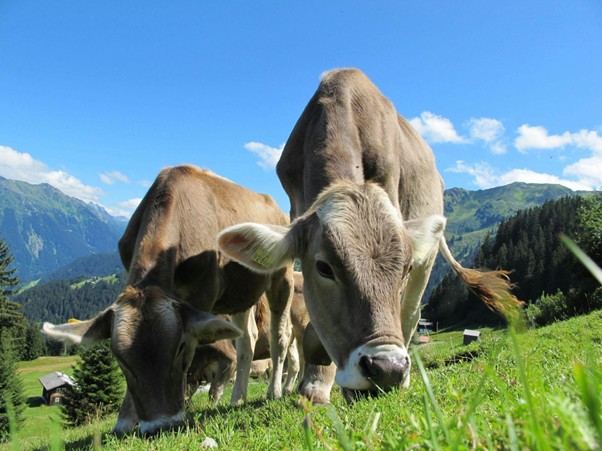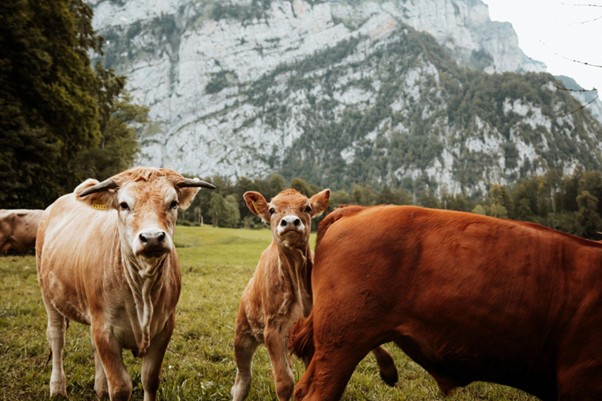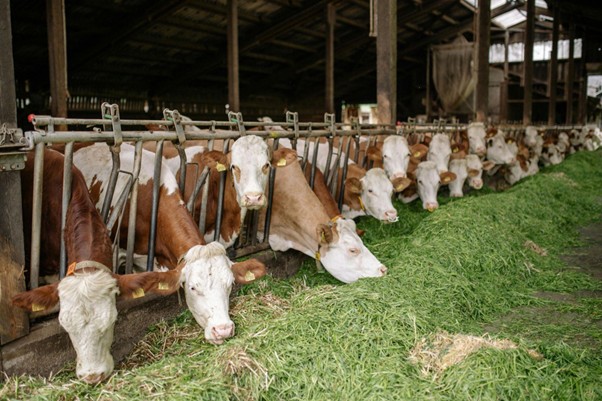Common Parasites in Cattle: Signs, Treatment & Prevention

Cattle parasites have a major impact on herd health, productivity, and the American cattle industry. They can significantly reduce growth, milk production, and reproductive performance, while also increasing susceptibility to diseases. Worldwide, farmers face losses exceeding US$21 billion each year due to these pests.
Effective parasite management is essential to minimize economic losses and maintain herd health. Key strategies include regular monitoring, proper nutrition, pasture management, and timely treatment, all of which help optimize productivity and protect the herd.
Common Parasites in Cattle

Cattle are affected by both external and internal parasites, each impacting health, growth, and productivity. Understanding their symptoms, seasonal patterns, high-risk periods, and transmission is essential for effective management.
External Parasites in Cattle
Common external parasites include grubs/maggots, lice, and mites. These parasites irritate the cow's skin, cause discomfort, and can lead to serious disease if left untreated.
Grubs
Grubs are the larval stage of certain flies that burrow under the skin to cause irritation and tissue damage.
- Symptoms: Swelling under the skin, lumps, pain, restlessness, reduced weight gain.
- Season: Active in late spring to early summer.
- High-Risk Periods: When adult flies lay eggs on the skin of cattle.
- Transmission: Larvae are deposited by flies on the skin and burrow under it.
Lice
Lice are small, wingless insects that feed on the blood or skin of cattle; they cause irritation and stress.
- Symptoms: Intense itching, hair loss, rough coat, skin lesions, decreased feed efficiency.
- Season: Can persist year-round, more common in winter when animals are housed closely.
- High-Risk Periods: Cold months and when animals are confined in close quarters.
- Transmission: Direct contact between infested animals or contaminated equipment.
Mites
Mites are tiny arachnids that burrow into the skin or live on its surface; they cause severe irritation and skin damage.
- Symptoms: Severe itching, scabs, hair loss, crusty skin, reduced weight gain.
- Season: Most active in colder months.
- High-Risk Periods: Winter, especially in dense housing conditions.
- Transmission: Direct contact between animals or through contaminated bedding and equipment.
Blowflies
Blowflies cause flystrike, a condition where adult flies lay eggs on the skin, and the hatched maggots feed on tissue, leading to pain and infection.
- Symptoms: Foul odor, moist or discolored skin, visible maggots, irritation, tail flicking, reduced appetite, or weight loss.
- Season: Most active in warm, humid weather and late spring through summer.
- High-Risk Periods: When cattle have open cuts from dehorning, castration, or injuries, or when their skin stays dirty or wet.
- Transmission: Adult flies deposit eggs on soiled or damaged areas; larvae hatch and feed on tissue.
Internal Parasites
Common internal parasites include roundworms (like Ostertagia and Cooperia), tapeworms, liver flukes, and coccidia. These parasites primarily affect the digestive system, nutrient absorption, and immunity.
Roundworms (Ostertagia and Cooperia)
Roundworms are intestinal worms that interfere with digestion and nutrient absorption. They can lead to poor growth.
- Symptoms: Diarrhea, poor growth, anemia, rough coat, reduced milk production.
- Season: Wet and humid months favor the survival of larvae on pasture.
- High-Risk Periods: Late summer to early fall; young and stressed animals are most susceptible.
- Transmission: Ingestion of larvae from contaminated pasture or feed.
Tapeworms
Tapeworms are flat intestinal worms that attach to the gut lining and absorb nutrients, causing weight gain.
- Symptoms: Poor weight gain, digestive disturbances, and occasionally mild diarrhea.
- Season: Year-round, depending on intermediate host availability.
- High-Risk Periods: When animals graze on pastures contaminated with intermediate hosts (like insects).
- Transmission: Ingestion of intermediate hosts carrying tapeworm larvae.
Liver Flukes
Liver flukes are flatworms that infect the liver and bile ducts. They cause tissue damage and impair liver function.
- Symptoms: Weight loss, anemia, jaundice, reduced milk yield, lethargy.
- Season: Wet and marshy conditions favor their life cycle.
- High-Risk Periods: Late summer to early fall, especially in wet pastures.
- Transmission: Ingestion of metacercariae (infective stage) on contaminated vegetation; requires snails as intermediate hosts.
Coccidia
Coccidia are microscopic protozoan parasites that infect the intestinal lining. They cause diarrhea and poor nutrient absorption.
- Symptoms: Diarrhea (sometimes bloody), dehydration, weight loss, poor growth.
- Season: Most active in warm, wet months.
- High-Risk Periods: Late summer; young calves are particularly susceptible.
- Transmission: Ingestion of oocysts from contaminated feed, water, or environment.
Symptoms of Parasites Affect Your Cattle

Each parasite causes a unique set of symptoms in cattle. Spotting these signs early helps farmers provide timely treatment and support herd health. The table below summarizes common symptoms of parasites and their effects for quick reference.
Risk Periods for Parasites in Cattle

Certain periods and conditions increase the risk of parasite infestations in cattle. Being aware of these high-risk situations helps farmers take preventive measures and protect herd health.
Young Cattle
Calves and young animals have underdeveloped immunity, making them more susceptible to both internal and external parasites.
Pregnant/Lactating Cattle
Pregnant and lactating cows are under physiological stress, which can reduce their resistance to parasites and increase vulnerability.
High-Density Herds
Cattle kept in crowded conditions are more likely to spread parasites quickly through direct contact or contaminated environments.
Wet, Warm Seasons
Parasites thrive in warm, humid conditions, making rainy or wet seasons a high-risk period for infestations.
Overgrazed or Short Pastures
Overgrazing forces cattle to feed closer to the ground, increasing the chance of ingesting parasite eggs or larvae.
Purchasing New Cattle
Introducing new animals without proper quarantine or deworming can bring parasites into an otherwise healthy herd.
Complications from Parasite Infections in Cattle

Parasite infections can cause a range of complications in cattle, affecting both health and productivity. The impact varies depending on the age and condition of the animal, with young and older cows being particularly vulnerable.
Effects on Young Cattle
Calves and young cattle are more susceptible to severe complications because their immune systems are still developing. Parasite infestations can lead to:
- Poor growth and weight gain
- Diarrhea and dehydration
- Weakness and lethargy
- Increased susceptibility to secondary infections
- If untreated, severe infestations in young cattle can even lead to death.
Effects on Older Cattle
In older cows, parasite infections may not always be fatal, but they can significantly affect productivity. Common complications include:
- Reduced milk production in lactating cows
- Poor reproductive performance
- Weight loss and reduced body condition
- Increased vulnerability to other diseases due to weakened immunity
How to Control Parasites in Cattle

Effective parasite control in cattle requires a mix of preventive management, regular monitoring, and targeted treatments. By combining internal, external, and general control practices, farmers can maintain healthy herds and minimize productivity losses.
Internal Parasite Control in Cattle
- Regular deworming following veterinary guidance
- Rotational grazing to reduce pasture contamination
- Allowing the pasture to rest for a few months so that the larvae can die
- Providing clean feed and water to prevent ingestion of parasite eggs or larvae
- Quarantining and treating new animals before introducing them to the herd
- Monitoring fecal egg counts to assess parasite load and treatment effectiveness
External Parasite Control in Cattle
- Using approved insecticides, pour-ons, sprays, or dips for lice, mites, and ticks
- Maintaining clean housing, bedding, and equipment to reduce parasite habitats
- Regularly inspecting animals for signs of external infestations
- Implementing pasture management to reduce exposure to flies and other external parasites
- Treating new or infested animals promptly to prevent spread
General Parasite Control in Cattle
- Keep housing areas, feeding equipment, and water troughs clean to limit parasite breeding and transmission.
- A balanced diet strengthens immunity and helps cattle resist infections more effectively.
- Avoid overgrazing and rotate grazing areas to break the parasite life cycle.
- Monitor cattle routinely for signs of weight loss, skin irritation, or digestive issues.
- Follow a veterinarian-recommended schedule based on fecal testing and seasonal parasite risks.
- Quarantine new cattle before introducing them to the herd to prevent introducing parasites.
- Regularly remove or compost manure to reduce parasite eggs and larvae in the environment.
Expert Suggestions for Effective Parasite Control in Cattle
Practical and timely parasite control helps protect herd health, improve productivity, and reduce economic losses and costs. Here are expert-backed insights to strengthen your parasite management program.
Best Time to Deworm
- Deworm at the start of the grazing season to minimize pasture contamination.
- Follow up with strategic treatments during peak parasite periods, especially after the rainy season.
- Treat young calves, pregnant cows, and newly purchased animals as priority groups.
- Base deworming schedules on fecal egg count tests rather than routine treatment alone.
Natural Remedies That Help
- Incorporate herbal supplements such as neem, garlic, and turmeric, known for their antiparasitic properties.
- Provide diatomaceous earth (food-grade) in feed to help reduce internal parasite load naturally.
- Use clean, dry bedding and fly-repelling herbs like lemongrass or eucalyptus around barns.
- Encourage multi-species grazing (e.g., alternating cattle with sheep) to interrupt parasite life cycles on pastures.
Common Mistakes Farmers Make
- Overusing dewormers, which leads to parasite resistance.
- Skipping fecal testing and relying solely on routine deworming.
- Ignoring external parasite control and focusing only on internal worms.
- Not quarantining new animals, which in turn allows parasites to spread to the herd.
- Overlooking record-keeping and not seeking timely veterinary intervention to treat the symptoms.
Signs That Parasite Control Is Working
You can tell your parasite control program is working when your cattle show steady weight gain, a shiny coat, improved feed efficiency, and increased milk production. Fewer signs of itching or irritation and more active, calm behavior also indicate that parasites are under control. Make sure to monitor your herd and keep a record of these positive changes.
Use FarmKeep for Cattle Management
Efficient herd management starts with accurate tracking, and FarmKeep enables it by helping you stay on top of every cow’s health and productivity.
With FarmKeep, you can:
- Record breeding, calving, vaccination, and deworming details.
- Monitor milk output, body condition, and reproductive performance.
- Schedule reminders for parasite control, feed updates, and vet visits.
- Access data-driven insights to improve herd performance and profitability.
FAQs
How often should I deworm cattle?
Calves are more susceptible to parasites and may need to be dewormed more frequently than mature cattle. It is recommended to deworm your cattle one or two times a year and calves at weaning.
How can I naturally control ticks and flies in cattle?
To control tick and fly infestation in cattle, keep housing clean, use herbal sprays like garlic, neem, or eucalyptus oil, and make sure to rotate pasture. Using fly traps and clean, dry bedding also helps reduce breeding sites.
Why do parasites return after treatment?
Parasites can reappear if the environment remains contaminated, if resistance develops due to overuse of dewormers, or if animals aren't treated at the right intervals.
How can I protect cattle during pregnancy from parasites?
To protect your cattle from parasites, provide them with a balanced nutrition diet, maintain clean housing, and use veterinarian-approved dewormers safe for pregnant cows. Avoid grazing in heavily infested areas.
What are the common intestinal parasites in cattle?
Common internal parasites include roundworms (Ostertagia, Cooperia), tapeworms, liver flukes, and coccidia.
What are the key symptoms of parasites in cattle?
Common symptoms of parasites in cattle include weight loss, diarrhea, poor coat condition, reduced milk output, itching, and general weakness.
How do I prevent and control parasite outbreaks in cattle?
To control parasite outbreaks in cattle, you must rotate pastures, deworm strategically, maintain hygiene, quarantine new animals, and monitor the herd regularly for early signs.



